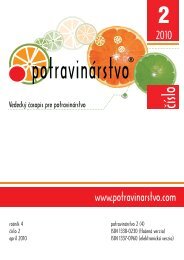You also want an ePaper? Increase the reach of your titles
YUMPU automatically turns print PDFs into web optimized ePapers that Google loves.
<strong>Potravinárstvo</strong><br />
Table 1: The summary of energy value and energy contribution of the main nutrients in tested food rations<br />
menu<br />
energy<br />
[kcal]<br />
energy<br />
from<br />
protein<br />
%<br />
energy<br />
from fat<br />
%<br />
energy<br />
from<br />
carbohydrate<br />
%<br />
protein<br />
[g]<br />
ročník 4 51 1/2010<br />
fat<br />
[g]<br />
carbohydrate<br />
[g]<br />
mean 1358,65 12,46 26,53 61 42,17 39,69 202,48<br />
SD 214,22 1,30 3,51 3,90 6,49 5,59 49,20<br />
V% 15,77 10,46 13,22 6,39 15,39 14,10 24,30<br />
Min. 1101,40 10,69 22,16 55,86 31,88 30,50 157,07<br />
Max. 1798,08 14,70 31,16 65,77 50,65 47,16 304,17<br />
Mediana 1281,78 12,06 25,90 60,77 44,35 40,39 184,20<br />
Daily amount of carbohydrates recommended for the<br />
researched population is 234 g, and kindergarten meals<br />
should provide it in an amount of 164 g. Total<br />
carbohydrate content in the tested meals was 202.48 g<br />
(table 1) which represents 123.44% of the recommended<br />
standards (Table 2) what was an evidence of too high<br />
carbohydrate intake.<br />
Also Gronowska-Seneger et al. (1998) found similar<br />
phenomenon. Analysis of the diets of children in preschool<br />
and school age, based on literature from the years<br />
1980-1995 in Poland, showed that the average dose of<br />
nutrition contained excessive amount of carbohydrate in<br />
the form of sweets and sugar. Kłos and Bertrand (1999)<br />
calculated the average content of carbohydrates in food<br />
rations as 230.9 g which represented 124% of standard for<br />
children aged 4-6 years. Grajeta et al (2003) noted similar<br />
results: the average amount of carbohydrate was 199.6 g<br />
which represented 122% of the recommended standards.<br />
Also, the results of Czech and Kęski (2007) showed an<br />
excessive amount of carbohydrates in the tested food<br />
rations. Moreover, Baginski and Stokowska (<strong>2006</strong>)<br />
showed that an oversupply of sugar in the examined<br />
population may be the cause of dental caries in this age,<br />
and thereafter contributes to obesity (Mc Conahy et al.,<br />
2004; Young, Nestle, 2002).<br />
Table 2: The comparison of the obtained results to the standards recommended for children aged 4 -6 years<br />
Energy and nutrient 70% daily norms Food rations<br />
% of RDI realization<br />
energy [kcal] 1190 1358,65 114,17<br />
protein [g] 38,50 42,17 109,50<br />
fat [g] 60,00 39,69 66,15<br />
carbohydrates [g] 164,00 202,48 123,44<br />
Children aged 4-6 years are recommended to consume<br />
proteins in the amount of 55 g of which meals in the<br />
kindergarten should provide 38.5 g of this nutrient,<br />
therefore, the amount of protein in the tested rations was<br />
too high. The average content of total protein in the tested<br />
food rations was 42.17 g (Table 1) which covered the<br />
recommended amount of this component of 109.53% of<br />
the recommended dose.<br />
Kłos and Bertrand (1999) found that the supply of<br />
protein in the meals in nurseries was 51.5 g, i.e. 137% of<br />
the recommended standards. Protein content in the study<br />
conducted by Grajeta et al (1998) was 46.2 g which<br />
represented 120% of the recommended standards (Table<br />
2). Czech and Kęska (2007) noted an average protein<br />
content which was 112% of the recommended standards.<br />
Similar results were obtained by Szponar et al (1996),<br />
who found an excessive intake of protein by making 24hour<br />
dietary interviews conducted with more than 150<br />
children aged 1-6 years. Stochacka-Tartar at al (2008)<br />
studied nutrition of preschool children, noted a similar<br />
dependence and concluded that even in the long period of<br />
intensive growth, an oversupply of protein may contribute<br />
to metabolic disorders.<br />
The average content of fat in meals was 39.69 g (Table 1)<br />
and covered the standard in average of 66 % (Table 2).<br />
Children aged 4-6 years are recommended to consume fat<br />
in the amount of 53-68 g a day, to facilitate interpretation<br />
of the results the average value was 60 g, while the<br />
kindergarten meals should provide an average of 42 g of<br />
this component. The analyzed food was consistent with the<br />
recommended standards for fat.<br />
Similar results were obtained by Szponar and<br />
Kierzkowska (1985), and Kłos and Bertrand and Czech<br />
and Kęska (2007) in their studies showed minor<br />
deviations from the total fat content of recommended<br />
standards. Different results were obtained by Gronowska-






